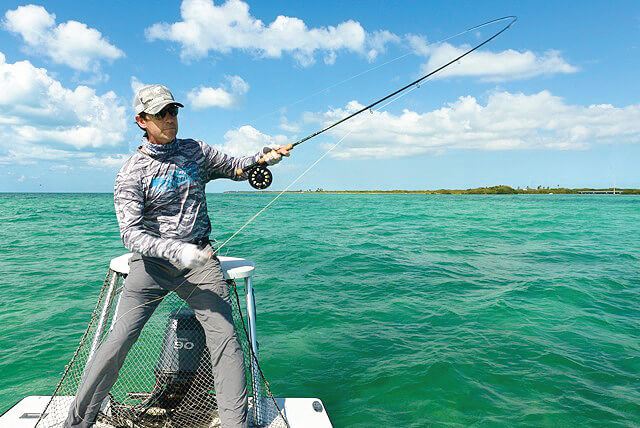A tarpon fly rod is a different tool than a trout or bass rod. The important part of a 10- to 12-weight tarpon rod is the ability to lift the fish at the end of the fight and try to break its spirit. So it’s not surprising to say the butt section is very, very stiff! Only the tip section of a tarpon rod can be loaded. In other words, only the tip bends. That is the “action” of the rod.
There are a few important points to make when casting a tarpon rod.
I know most of us think we have to learn to cast a long way when going tarpon fishing, and yes, it is important to know the essentials necessary to cast a long way, but more often it is a short, 40- to 60-foot cast in windy conditions. When casting a tarpon rod, you need to understand the construction of your rod so you can cast narrow loops into the wind. Simply stated, the butt of the rod is very stiff to give it lifting power. Only the tip section of a tarpon rod bends. I call this tip casting because the rod is designed to only bend at the tip, as I’ve said at least three times now.
The most common casting error, in this case, is the angler doesn’t make the necessary adjustment to the casting arc with a tarpon rod in his hand. More to the point, to form a tighter loop, shorten the casting arc. If the rod arc is too wide (45-90 degrees), the rod tip path will be convex, causing the loop size to be very large. Although it may be counterintuitive, try a shorter stroke length and arc (30 degrees) during the acceleration phase of the cast, and you will start to get that tarpon rod under control. Try it.
Check out the Federation of Fly Fishers website. If you don’t know these terms, it will help you understand the following: To cast the heavier tarpon rods and achieve the straight line path of the rod tip (SLP) on the backcast, stop the rod a little sooner in an upward direction and then drift. On the forward cast, after translation, and during the rotation, don’t drop the rod tip down much below the oncoming line.
A few other tips: Remember to use the 180-Degree Rule, and the cast will perform much better. Here’s how it works. If you are casting into the wind, remember to use a back cast with a high trajectory, like the angle on the roof of your house. Then on the forward cast, aim low at the water.
One last thing about the line, tarpon fly lines have specialty tapers. They have a short belly (fat part), so you don’t have to have a lot of line out of the rod tip to make those short casting strokes and load the rod like it should be.
Try these tip casting tips. The next time you are in front of a tarpon coming at you with a 15 mph wind, stay calm. Good luck!
